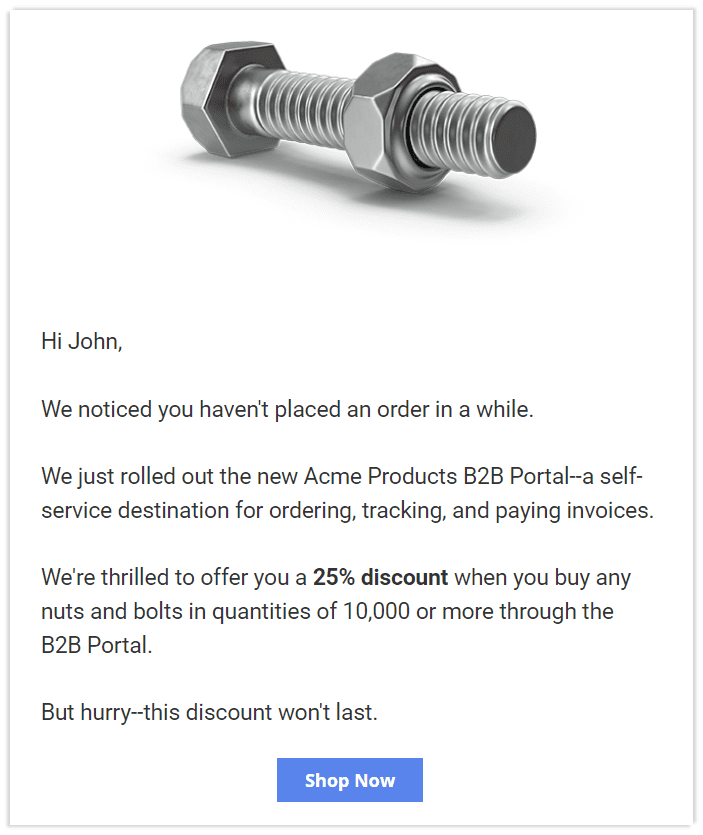Share
Author
Corevist Marketing Team
Share
So you’ve launched your B2B ecommerce portal. Now what?
The journey doesn’t end with your launch. In fact, that’s just the beginning. Most of our clients implement a B2B ecommerce portal with specific goals in mind: increasing revenue without increasing cost, reducing customer service time spent on handling orders, enabling 24×7 self service, and so on. But these gains are only realized through increasing adoption and usage.
Have no fear, you can do it!
In this post, we’ll cover 5 keys to driving adoption of your new B2B portal.
1. Your online experience MUST be better than your offline experience
As a general rule, people won’t make a change unless they have a good reason to do so. You have to give them that reason—by creating a superior online experience.
Here are a few key components of a great experience.
Offer a better price
Offer a discount for products purchased through the website. Even a limited-time discount can help drive traffic to your B2B ecommerce site. While it’s hard to let that revenue go, remember that the lower cost of the digital sale offsets whatever discount you’re offering.
Create an email campaign for all customers who have ordered over the last year, showing off the new website and all the advantages of 24×7 self-service. Be sure to add a call to action in your email campaign, such as a discount on first purchase.
Give customers everything they need in the B2B portal
Make sure your website experience includes a product catalog with great content that is easily accessible. Product specifications, configurable products, color images, reviews and recommendations all contribute to a great experience for your customers.
2. Get buy-in from your sales staff
If you have sales reps, they own the relationship with your customers (or they should). That means if you want to influence customers, you should turn to sales.
When it comes to B2B ecommerce, you may need to handle this with care. Sales reps may feel threatened if you’re making it easy for customers to buy through self-service. After all, what’s going to happen to their commissions?
The key is to design your B2B ecommerce program to benefit both customers and reps. That means creating incentives for reps to tout the B2B ecommerce store.
Here are some concrete ways to get your sales reps engaged.
Redesign your sales commission plan
Ensure you are incenting your reps to help drive traffic. Do they receive less commission but don’t have to take as many routine orders? Make sure you have the right incentives that encourage the behavior you are looking for.
Ask sales reps to gather feedback
Feedback is important! Encourage your sales team to work together with marketing to increase traffic, based on feedback they are hearing from your customers.
Give reps the B2B ecommerce training they need
Retrain your sales team so they are comfortable giving customers a quick demo to help with their first orders. A personal touch goes a long way to making customers feel at ease.
3. Leverage your customer service reps
Customer service reps are your secret weapon. They carry the burden of manual interaction with customers through phone, fax, and email—which means they have a lot to gain when customers switch to self-service. With reps no longer handling routine inquiries about orders, line items, and tracking numbers, they can transition to higher-value tasks. These are more fulfilling for them, plus they create more value for the customer and your business.
Here are some concrete ways to engage your CSRs.
Put a footer at the bottom of every CSR’s email that references the website
It’s a small touch, but it provides transparency to the customer, which helps build trust with your brand. It also increases traffic to your B2B ecommerce portal. Bonus points if you set up a UTM code on the link in the email, so you can see how many customers reach the portal this way.
Task CSRs with driving adoption on every phone call.
When you ask customers to make a change (like switching to self-service), a human touch goes a long way to building trust. It’s amazing what CSRs can achieve with simple questions on every call.
- “Have you ever logged in to the B2B portal to see your real-time credit status?”
- “Did you know you can pay your invoice online?”
- “Did you know you can check order status, including deliveries, online?”
4. Market the B2B ecommerce site wherever you are
Any time you interact with someone from outside your organization, it’s a marketing opportunity. You never know how those dots will connect. You don’t have to be pushy—you just want to make it known that you have a B2B ecommerce site.
- Include your website portal in all literature used at industry trade shows and events
- Be sure to get email addresses through all offline purchase channels and email them to push them to the website
Of course, every audience and customer segment has different needs. Evaluate whether your marketing plan should vary by sales channel, partners, dealers, or distributors.
5. Review your metrics to get the full story
It’s not enough to just do things. You need to measure your results and adjust accordingly.
Luckily, B2B ecommerce analytics make it easy to see what’s going on.
This is a huge topic with much to learn. A partner like Corevist can help you understand what you should track (and how to adjust your efforts based on data). But at a high level, here are several ways to measure your success.
Track your B2B ecommerce adoption rate
Take the total number of customers placing orders and divide it by the total number of customers invited to use your B2B ecommerce portal. This is your adoption rate.
Track cart abandonment and site bounces
Look at your metrics for signs your customers are coming to the website but not ordering, such as site abandonment. Look specifically at the behavior at the time of abandonment. It may be a sign that you need to improve the user experience.
Track adoption by region or geography
Are you getting higher usage in one region versus another? If so, dig into what’s specific to this region. Then engage your sales and customer service staff to implement the tactics discussed above in light of regional preferences.
Clearly, there’s much to learn! For an in-depth perspective on metrics, check out this post: The True Measure Of Success In B2B ecommerce.
The takeaway
Driving adoption doesn’t have to be hard. With these concrete tactics, you’ll have a great toolset for introducing your customers to the value of your B2B ecommerce portal. The key is to start with the lowest-effort tactics, get quick wins, and keep the momentum going. That’s what we advise our clients to do here at Corevist.
Want to become Easier To Do Business With?
Check out the Corevist Platform.
Managed B2B portals and ecommerce with prebuilt integration for ECC and S/4HANA.











